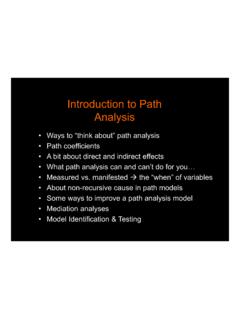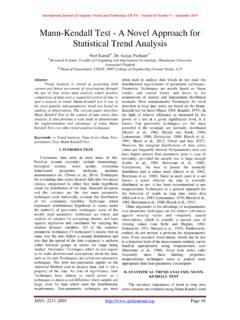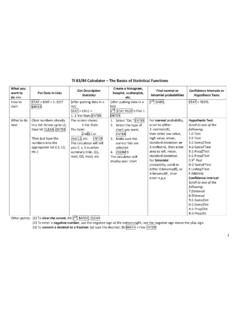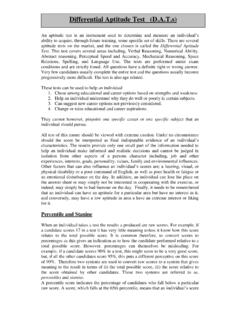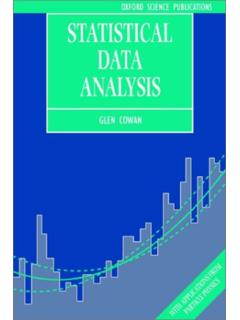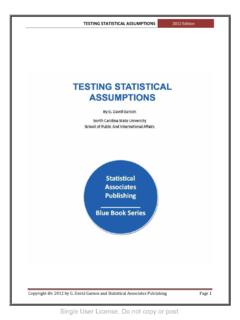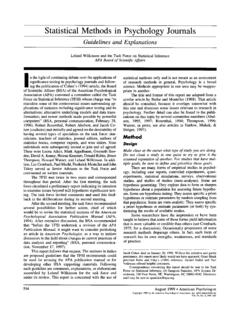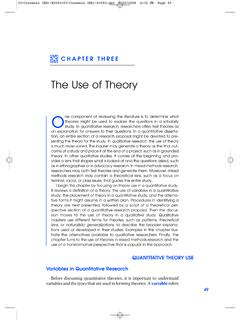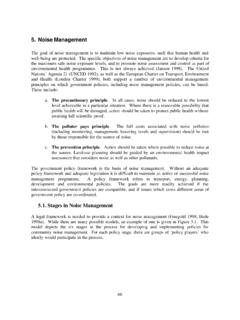Transcription of The Mann-Whitney U-test -- Analysis of 2-Between-Group ...
1 The Mann-Whitney U-test -- Analysis of 2-Between-Group Data with a Quantitative Response Variable Application: Compare the distributions of scores on a quantitative variable obtained from 2 independent groups. Thus, it is applied in the same data situation as a t-test or an ANOVA for independent samples, except that it is used when the data are either importantly non-normally distributed, the measurement scale of the dependent variable is ordinal (not interval or ratio), or from a too-small sample. There are two versions of the Mann-Whitney U test, one for small samples ( , when n < 20 for each group) and one for large samples. It is important to remember the null hypothesis for this test, and to differentiate it from the nulls for the t-test and the median test.
2 H0: The two populations represented by the two conditions (groups, samples) have the same distribution of scores. To reject H0: is to say that the population distributions are different in some way, center, spread and/or shape. When the forms of the distributions are similar (as is often the case compare the size and symmetry of the IQR from the two conditions), then rejecting H0: is interpreted to mean that one population tends to have larger scores (or a larger median) than the other. Special Note: There is another statistical test very similar to the Mann-Whitney U, called the Wilcoxin signed-ranks test. The two tests were designed at about the same time, following the same logic and mathematical principles.
3 In fact, having computed one of these statistical tests , the researcher can transform their results into the other statistic using a fairly simple formula (much as one can transform a t-value into an F-value, and vice versa). The choice to present the Mann-Whitney U (instead of the Wilcoxin), and this version of the computation in particular was made based on simplicity - this is the most straightforward computational scheme I could find. The complexity, especially for the Wilcoxin, comes from the different possible summary values that can be obtained depending whether the larger or the smaller sample has the higher or lower scores. While there are rules for deciding the correct computations, the procedure described below avoids this issue by using a clever variation of the critical value table.
4 The data: This Analysis involves the grouping variable reptdept (1 = not separate reptile department, 2 = separate department), and the response variable reptgood (rating of reptile quality - 1-10 scale) . Below are the scores for the 12 stores (reptdept, reptgood). 1,2 2,8 2,9 2,7 1,4 1,7 2,4 1,4 1,5 2,9 2,7 1,2 Research Hypothesis: The researcher hypothesized that stores with separate reptile departments would have reptiles of better overall quality than stores that did not have separate reptile departments. H0: for this Analysis : Pet shops that do not have separate reptile departments have the same distribution of reptile quality ratings as shops that do have separate reptile departments.
5 Step 1 Rearrange the data from lowest to highest score while keeping track of group membership, and assign a rank to each score. If there is a tie, all of the scores that tie receive the average rank of that set of scores. Group 1 1 1 1 2 1 1 2 2 2 2 2 Reptgood 2 2 4 4 4 5 7 7 7 8 9 9 Rank 4 4 4 6 8 8 8 10 Ave.
6 Of ranks 1 & 2 Ave. of ranks 3,4 & 5 Ave. of ranks 7,8 & 9 Ave. of ranks 11 & 12 Step 2 Compute the sum of the ranks for one of the samples (it really doesn't matter which) For group 1 (not separate departments) Ta = + + 4 + 4 + 6 + 8 = 25 Step 3 Determine the sample size for the sample for which you computed the total ranks in Step 2 na = 6 Step 4 Determine the sample size for the other sample nb = 6 Step 5 Compute U using the following formula na *( na + 1 ) 6 * (6 + 1) Ua = ( na * nb ) + --------------- - Ta = (6 * 6) + ----------- - 25 = 2 2 42 = 36 + ------- - 25 = 32 2 Step 6 Determine the value of U to compare to the U-critical value.
7 The value you will compare to the U-critical value will be the smaller of : Ua and Ub = ( na * nb ) Ua For these data Ua = 32 and Ub = ( na * nb ) Ua = (6*6) 32 = 4 We would use Ub = 4 For small samples (n < 20 for each group): Step 7 Determine the critical values of U using the table. The rows and columns represent sample size for each group (it doesn't matter which group is used for rows and which for the columns). Look down the appropriate column and across the appropriate row to find the critical value. For the example data, you look down the column labeled n1 = 6 and across the row labeled n2 = 6, and find the critical values of 5.
8 Step 8 Compare the obtained U and the critical U values to determine whether to retain or reject the null hypothesis. -- if the obtained U value (from Step 6) is larger than the critical U value, then retain H0: -- if the obtained U value (from Step 6) is smaller than the critical U value, then reject H0: For the example data, we would decide to reject the null hypothesis, because U=4 is smaller than the smaller critical value of 5. For large samples (one or both groups with n > 20): With samples this large, the value of U approaches a normal distribution, and so the null hypothesis can be tested by a Z-test. Step 9 Compute the standard deviation of U ( na * nb)* ( na + nb + 1) (6 * 6) * (6 + 6 + 1) Std dev = ------------------- --------------------- = 12 12 Step 10 Compute z U - ((na * nb)/2) 32 - ((6*6)/2) Z = --------------- = ----------------- = Std dev Step 11 Compare the obtained Z value and the critical Z value to determine whether to retain or reject the null hypothesis.
9 -- if the absolute value of the obtained Z is less than , then retain H0: -- if the absolute value of the obtained Z is greater than , then reject H0: For the example data, we would decide to reject the null hypothesis, because the absolute value of the obtained Z ( ) is greater than the critical value of For both small and large samples: Step 12 IF you reject the null hypothesis, determine whether the data support or do not support the research hypothesis. -- IF you reject the null hypothesis AND the group that was hypothesized to have the larger scores does, then the research hypothesis is supported -- IF you retain the null hypothesis OR you reject the null hypothesis BUT the group that was hypothesized to have the larger scores actually has the smaller scores, then the research hypothesis is not supported.
10 By the way: Usually the researcher hypothesizes that there is a difference between the conditions. Sometimes, however, the research hypothesis is that there is NO difference between the conditions. If so, the research hypothesis and H0: are the same! When this is the case, retaining H0: provides support for the research hypothesis, whereas rejecting H0: provides evidence that research hypothesis is incorrect. For the example data, we would decide that the research hypothesis is supported, because the null hypothesis was rejected, and because, as hypothesized, the stores with the separate reptile department tended to have the larger scores. Step 13 Reporting the results You will want to compute medians and IQR values to help describe the data before reporting the results of the significance test.





